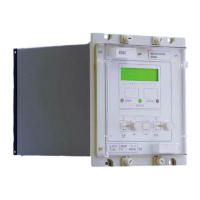VCG202/EN M/H11
Technical
Figure 23: Shorting of Circulating Current Control Pilot Wires
Contact A – OPEN for parallel control
CLOSED for independent control
Contact B – OPEN when local LV CB is closed
CLOSED when local LV CB is open
4.7.4.2 Circulating current control with LDC
Where parallel transformers feed distribution lines and pilot wires are connected to
provide circulating current control a series or a parallel connection of the LDC circuits can
be used to provide correct LDC.
4.7.4.2.1 Parallel connection of LDC circuits
Traditionally, the LDC circuits of similar parallel transformers have been connected in
parallel. Each relay then measures a current which is proportional to the load current of
the power transformer irrespective of the number of parallel transformers in the scheme,
see Figure 24. Therefore, when the number of transformers supplying the load changes,
the LDC settings on the relay will not need to be adjusted.
Traditionally, when paralleling LDC inputs, it was assumed that the load currents would
split equally between paralleled LDC circuits as the LDC impedance of the
electromechanical VRR’s was large compared to the interconnecting lead resistances.
The KVGC202 has a LDC burden of 0.007 ohms. This is insufficient to ensure that
interconnecting lead resistances are negligible. Therefore, when the LDC circuits are
paralleled, it is necessary to pad out the burden of the LDC circuits by use of an external
swamping resistor.
If both power transformers are the same they will share the total load current, 2 IL.
Therefore, with the swamping resistors in the LDC circuit each LDC input to the relay will
see the average of the 2 load currents from each transformer, (IL+IL)/2 = IL. If one
transformer is out of service then the LDC circuits now sees (2IL +0)/2 = IL. Therefore,
when the number of transformers supplying the load changes, the LDC settings on the
relay will not need to be adjusted.
However, the voltage drop in the feeders from the busbar is based on the total load
current, 2IL, but each LDC circuit only sees half this value, for 2 parallel transformers.
Therefore, the LDC resistive and reactive volt drop settings, VR and VXL as calculated
earlier for a single transformer must be doubled i.e. based on 2 x rated current. The VR
and VXL settings should be adjusted similarly, for 3 or more transformers in parallel, for
example the standard settings should be multiplied by 3 for three transformers in parallel.
It should be remembered that when the LDC input CTs are paralleled, the LDC circuits
will not see any components of the circulating current between parallel transformers,
therefore negative reactance compensation cannot be used to combat circulating current.
Only the ‘pilot’ method of circulating current control or external means of control can be
employed.

